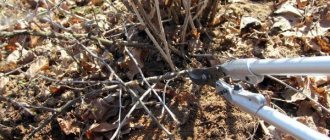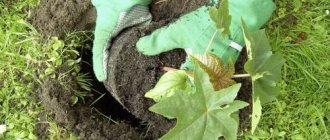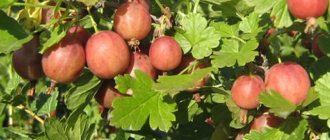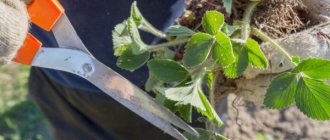When is the best time to plant: spring or autumn
You can diversify your garden with a new berry bush both in the fall and in the spring.
- However, planting gooseberry seedlings in the fall has a number of advantages:
- seedling survival rate in autumn is higher;
- with the beginning of spring, the plant immediately begins to grow, without wasting energy on rooting;
- the possibility of obtaining a harvest in the first season.
Pros and cons of autumn planting
Gooseberries are traditionally planted in early spring or autumn. The number of “risks” on survival is much less with the second option, and here’s why:
- in the fall, young gooseberries manage to take root before the first serious cold weather;
- the soil around the bush will be well compacted naturally over the winter, which will provide better nutrition for the roots in the future;
- in the spring the bush will begin to fully grow and develop, it will not be afraid of drought and repeated spring frosts;
- It’s easier to choose the time for planting in the fall; you just need to have time to plant the plant about 2 weeks before the first frost.
There are also disadvantages to planting gooseberries in the fall:
- in the case of a very cold (up to 40 ℃), little snow and long winter, the young plant may not survive;
- increased requirements for the quality of autumn seedlings (they must be completely healthy in order to have time to take root before the cold weather).
On a note. The disadvantages of autumn planting can be turned into one big advantage: if the seedling survives the first winter, this means that it will not take up space in the garden in vain. A rich gooseberry harvest is guaranteed.
Autumn planting dates in different regions
So that the gooseberry root system has time to take root and the plant does not freeze in winter, it is necessary to plant at the correct time. Rooting of a seedling takes about 20 days , and this is exactly the interval before the onset of frost that must be ensured.
On average, this period occurs from mid-September to mid-October, depending on the region of residence.
Did you know? In the 70s of the 20th century, a hybrid of gooseberries and black currants, called joshta, was created in Germany. The hybrid has no thorns and is resistant to many diseases and pests.
According to the lunar calendar
Many gardeners follow the recommendations of the lunar calendar when planting and caring for plants. According to them, in every month there are favorable and unfavorable days for planting and replanting.
For gooseberries in the fall of 2021, the following data is given:
- the best days for planting in September are 8–9, 18–19 and 22–24;
- the best days for planting in October are the 15th–16th and 20th–21st;
- It is not recommended to plant on September 27–29 and October 27–29.
Popular mistakes when planting gooseberries in autumn
Beginning gardeners, who are poorly aware of the characteristics of the shrub, often make mistakes when planting it. In order not to step on the same rake, it is better to familiarize yourself with typical misconceptions in advance and protect gooseberries from your own bad influence by eliminating the following most likely mistakes:
- Initially, a low-quality seedling .
- The wrong planting dates are chosen either too early (the seedling may have time to begin to vegetate), or too late (the root will not have time to develop sufficiently and the seedling will die due to its freezing).
- is too shaded .
- The need to add a sufficient amount of nutritious soil and fertilizers to the planting holes is ignored.
- Bushes are planted too close to each other . Heavily dense plantings are poorly ventilated, which is why the plants begin to hurt. Or, as a result of a lack of sunlight and nutrients, the berries are set too small.
- There is no pruning after planting .
- Proper post-planting care is not provided , namely, sufficient humidity is not maintained.
Well, let your gooseberries be as tasty as they are prickly (although now non-prickly, thornless varieties are gaining popularity)!
Thus, now you know how to properly plant gooseberries in the fall at your summer cottage. It's not that difficult, is it? All that is required of you is to carefully follow these instructions and everything will definitely work out!
Video: how to properly plant gooseberries in the fall - features of planting and care
Variety selection
The plant can have fruits in different shades of green and red. When choosing a variety, you should pay attention to the tasting characteristics of the berries and the plant's resistance to disease . The absence of thorns will make harvesting much easier, and by planting several bushes with early ripening, you can get tasty and healthy berries longer. Almost all gooseberry varieties are partially self-fertile, but pollination with pollen from other varieties increases both the size of the berries and the overall yield.
Did you know? In Ancient Greece and Rome, they knew nothing about gooseberries, so there are no legends or myths about its origin.
The sweetest of the zoned varieties are:
- Beryl - its bushes are distinguished by excellent winter hardiness and high yield (3–10 kg per bush). The shoots are pricked only in the lower part, which does not interfere with the collection of large (2.8–3.4 g) light green berries. Sensitive to septoria, resistant to powdery mildew.
- Ural emerald - has an average number of thorns along the entire length of the shoots and produces from 2.1 to 5.6 kg per bush. The average weight of green berries is 4.3 g. The low-growing bush is frost-hardy and quite resistant to anthracnose and powdery mildew, sawflies and moths.
- Pink-2 is quite demanding in terms of growing conditions, but its dark red berries weighing 5–7 g (up to 10 g) received 4.9–5 points for taste. There are few thorns on the shoots. The winter hardiness of the variety is average, and the yield is 3–4 kg per bush.
Selection and preparation of a site
Another paradox of the gooseberry: it loves the sun and warmth very much, but can die with prolonged aggressive exposure to hot sun rays. How do gardeners solve this puzzle? The best planting location is where the bush will be well lit in the first half of daylight. It’s good if there are tall plants, buildings, or a fence on the southwest side.
Almost all fruit trees with deep roots (pear, apple, plum) are suitable neighbors for gooseberries. If you plan to plant several bushes on a plot, the best way is to do it compactly, in rows, so that there are no problems with pollination. Works well on gooseberries and tomato bushes. Red currants and grapes do not interfere.
Do not plant with plants that have an aggressive, rapidly growing root system: strawberries, raspberries. Gooseberries will also wither under walnuts. A bad neighbor and an undesirable predecessor is black currant, from which any disease can spread. But if potatoes, legumes or clover grew on the site before, the seedling will reward you with a good harvest.
Gooseberries are not able to accumulate excess moisture. Therefore, the ideal slope of the site is 5-15 degrees. This is the case when the water will not stagnate, but will not go away too quickly. Gooseberries love light loam and do not respond well to high acidity.
On a note. Fertile, “breathing” soil is ideal. If you add one and a half buckets of high-quality humus to the planting hole, you don’t have to worry about feeding the bush for the first three years.
Landing rules
In order for a plant to produce a full harvest, it is necessary to provide it with an optimal position on the site. The quality of the seedling and proper planting are also important components of success.
Selecting a location
In general, gooseberries are unpretentious crops. The main conditions that the landing site must meet are:
- good lighting;
- protection from strong winds;
- The groundwater level is not higher than 1 m.
Bushes are often planted between dwarf fruit trees or next to a fence, which provides good protection for the plants from the wind.
Flooding is detrimental to the gooseberry root system, so the area should not be flooded during the snowmelt period
It is not recommended to plant gooseberries after raspberries or currants, since these crops have common pests. It is worth considering that the plant can bear fruit in one place for up to 20 years or more . When planting several bushes, approximately 1.25–1.5 m should be left between them (depending on the variety). Too thick placement subsequently leads to a lack of light and air, the rapid development of diseases and a decrease in yield.
The crop will not grow in acidic soils; the soil should be loamy or sandy loam, with a good percentage of organic matter. If the acidity is above 5.5 pH, lime should be added to the soil at the rate of 200–300 g per 1 m².
Planting gooseberries in the ground in autumn
Preparing for landing
To grow gooseberries, choose seedlings that are one or two years old - they adapt much faster and more easily than three or four year olds. Seedlings should have at least three skeletal roots about 15 cm long with yellow bark, fibrous roots should also be well developed, and the ground part should be one or two shoots up to 40 cm high.
- Blackberries: growing in the garden, propagation, varieties
Before planting, you need to remove all the leaves from the seedling by carefully running it along the shoots from bottom to top with a loosely closed gloved hand. Then you should cut off damaged or dry roots, and then put the roots in a clay mash with the addition of a root formation stimulator. Make a mash for 15-20 seedlings according to this recipe: 1 kg of chernozem and 1 kg of clay, 1-2 bags of Kornevin, 6 g of Aktar are diluted with three liters of water and mixed thoroughly.
Then plant gooseberries
In a small summer cottage, gooseberries are usually planted along the fence or between fruit trees, but the latter option is not the best - the roots of the trees dry out the soil. The best predecessors for gooseberries are row crops - early potatoes, beets, peas, beans, as well as lupine and clover as green manure. Gooseberries cannot be grown after currants and raspberries. Do not plant gooseberries next to currants, because they have common diseases and pests.
Soil for gooseberries
Gooseberries need more elevated and illuminated places than currants. It loves slightly acidic or neutral (pH about 6), rich in humus, breathable chernozems and loams, in which groundwater is located no higher than at a depth of 1.5 m. Soils that have not been cleared of weed roots, in particular wheatgrass, are not suitable for gooseberries. will do.
Care
Caring for gooseberries is comparable to caring for currant bushes, but it also has some features that will be discussed below.
We recommend reading about the features of spring gooseberry care.
Watering, fertilizing
Gooseberries are sensitive to moisture near the root collar, so they should not be watered directly under the root. It is best to dig a small groove around the perimeter of the crown for this purpose. The plant needs watering at the following times:
- after flowering;
- in the berry ripening phase;
- after harvest.
In warm, dry autumn, moisture-charging irrigation is also carried out (30 liters per bush), but if September was rainy, it can be excluded.
The crop needs additional nutrition, since it is characterized by high productivity . From the period of bud opening until the growth of new shoots stops, gooseberries especially need nitrogen, and after harvesting the fruits, they should be fed with phosphorus-potassium fertilizers.
We advise you to learn how to feed gooseberries in spring and autumn.
One adult bush will need about 20 kg of manure or 80–120 g of superphosphate, 70–100 g of potassium chloride and 65–80 g of ammonium nitrate during the year. It is recommended to alternate the use of organic and mineral fertilizers every other year.
During the period of berry formation, gooseberries can be fed with a solution of mullein, bird droppings, or the following composition (per bucket of water):
- 30–50 g ammonium nitrate;
- 20–30 g of potassium chloride;
- 50–80 g superphosphate.
Loosening, weed removal
To ensure rapid growth, young gooseberries need moist, loose and clean soil. As soon as the snow melts, you should loosen and mulch the ground under the bushes . For mulching, you can take either organic peat, humus or straw, or black film, in which cuts are made for watering and fertilizing.
Important! The depth of loosening the soil should not exceed 10 cm, since the root system of the crop is not deep.
Pruning, seasonal features
Pruning gooseberries when planting creates conditions for active spring growth and branching. Each shoot must be shortened to 2–4 buds. In the spring, when new shoots begin to grow, 3–5 are left and the rest are cut out . In varieties with low branching, the tops of these shoots should be shortened, and if the variety branches well itself, this stage can be omitted.
Throughout the growing season, sanitary pruning is carried out, removing diseased and broken parts of the plant. After 6–8 years of fruiting, the shoot forms smaller berries, and such a branch is cut out
This pruning is performed every year; an adult bush should consist of 3-4 branches each year. With sufficient distance between plants, the number of shoots per year can be increased. In this case, you should pay attention to the growth of a particular specimen:
- with active growth of young shoots, intensive pruning is carried out;
- if the number of new branches is small, reduce pruning.
Important! Experienced gardeners recommend leaving it at 1
–
2 more zero shoots, in case the branch is damaged. Such spare shoots are subsequently removed.
How to plant gooseberries in the fall: features, requirements and step-by-step instructions
For spring planting of gooseberries to be successful, you need to:
- buy a quality seedling;
- choose a suitable location on the site;
- prepare and fill the planting hole;
- plant the seedling correctly;
- follow simple but mandatory rules for care after planting.
Next, we will analyze all the main points in more detail.
Video: how to plant gooseberries - planting in autumn
Selection and preparation of seedlings for planting
To choose a high-quality gooseberry seedling, you should be guided by the following basic criteria:
- It is best to give preference to two-year-old gooseberry bushes, which have a well-developed root system (about 25-30 cm in length), and the above-ground part consists of 2-3 strong shoots, at least 25-30 cm long.
When purchasing seedlings with an open root system (ROS), it is very advisable to purchase 2-year-old specimens. But seedlings with a closed root system (ZRS) can be purchased at either 1 or 2 years of age.
- Naturally, the seedling must have a healthy appearance without any signs of disease or pest damage ( glassworm , powdery mildew , etc.), as well as mechanical damage.
A seedling in a container (with a ZKS) should have a lot of leaves, and the length of the shoots should be about 30-50 cm. Assessing the root system is quite difficult, but it is possible. The seedling should sit firmly in the container, this will mean that the roots are well entwined with the earthen ball and the plant was originally grown in a pot, and was not transplanted a couple of days ago.
Variety selection
The main scourge of gooseberries is powdery mildew (spheroteca) . Therefore, if you do not want to constantly fight this dangerous fungal disease, then you should purchase and plant the most resistant or weakly affected gooseberry variety, for example, Russian, Kolobok, Orlenok, Northern Captain, Vladil, African, Zolotoy Ogonek, Komsomolsky, Muscat, Fertile, Northern grape.
How to prepare a seedling
After purchasing and before planting, you will need to somehow store the seedling, namely, you should wrap the roots with a damp cloth and place it in a bag.
Before planting a seedling, for better survival, its rhizomes can be dipped in a clay mash, reminiscent of thick sour cream in consistency, or kept in any root formation stimulator (for example, Heteroauxin or Kornevin) for a couple of minutes.
Advice! Also, before planting, it is recommended to trim too long and dried roots, shortening them to 20-25 cm (or living tissue) and completely cutting out damaged ones.
Choosing a landing site
Gooseberries prefer sunny places, so you should choose a well-lit and open area.
By the way! In principle, gooseberries will grow quite normally in light partial shade, but not in the shade.
In no case should you plant gooseberries in lowlands, swampy and waterlogged places, as is the case if you have close groundwater (closer than 1.5 meters).
In this case, you can plant gooseberries on an artificial hill.
Suitable soil
Gooseberries like to grow on light (loose) and fertile soils, such as loam or sandy loam soil. In this case, the acidity of the soil should be neutral.
Gooseberries really do not like acidic soil. You can reduce the acidity (deoxidize) the soil by adding dolomite flour , slaked lime, chalk or wood ash .
Naturally, if you periodically apply fertilizers and carry out regular watering, gooseberries will grow well on poorer sandy or clay soils.
However, if the soil is excessively clayey, the water will stagnate, the root collar will rot and the seedling will simply disappear. On the contrary, if the soil is too sandy, the seedling may dry out from lack of moisture, which will evaporate very quickly after watering.
Advice! To make clay soil loose, it is mixed with sand. If the soil on the site is sandy, then clay is added to it.
At what distance to plant
As a rule, it is recommended to leave a distance of 1.2-1.5 m from each other between gooseberry bushes, the row spacing is 2-2.5 m. This distance between the bushes is necessary due to the fact that when growing, adult bushes fill enough there is a large space, and harvesting from individual bushes is much faster and safer than from a thorny hedge.
Important! In order for gooseberries to develop normally, the distance to the fence must be at least 1, and preferably 1.5 meters.
Rules for the neighborhood of cultures
Many gardeners wonder whether it is possible to plant gooseberries next to currants.
Some people think that they are harming each other, but in reality this is not the case. Another thing is that they have common diseases and pests, and if one crop is infected, the second will most likely also suffer.
In any case, you should not plant too close to raspberries, because raspberries will simply shade your gooseberries.
At what depth to plant (what should be the planting hole)
The optimal dimensions of the planting pit for gooseberries are 50 by 50 centimeters (depth and width/diameter), but it can be wider and deeper (up to 60 cm).
Remember! The larger the hole, the more fertile soil can be placed in it.
When planting, it is important to take into account one very important point - the root collar must be buried no less than 6-7 cm, otherwise the shoots growing from the root will be weak.
Advice! If you are planting a seedling in a container (with a ZKS), then simply make a hole 2-3 times larger than the container itself.
How and with what to fill the planting hole
In order for the plant to quickly take root in a new place, the planting hole for planting gooseberries should be filled with fertile substrate (soil mixture), namely, organic and mineral fertilizers should be added:
Important! Mineral fertilizers must be thoroughly mixed with soil and humus.
- the top fertile layer of soil (which you still have after digging a hole);
- compost or humus (bucket);
- deoxidized high-moor peat (optional and possible);
- superphosphate (80-100 grams) or 300-400 grams of bone meal;
- potassium sulfate or potassium salt (30-40 g) or 300-400 g of wood ash .
Or you can simply pour about 100 grams of diammofoska (or, in extreme cases, nitroammofoska), of course, if you use mineral fertilizers.
Direct landing
Step-by-step instructions for planting gooseberry seedlings in the fall:
- Fill the planting hole halfway with the nutrient mixture.
- Further, if desired (many people water only after planting, others - both before and after - as you prefer), you can lightly spill the nutrient soil with water.
- Make a small cone-shaped mound in the center of the planting hole.
If you are planting a seedling with a closed root system (in a container), then you do not need to make any mounds, but simply plant it in a prepared planting hole without disturbing the earthen coma.
- Place the seedling in the center of the mound and spread the roots downwards on the sides (the roots should under no circumstances bend or stick up!).
Note! Gooseberries, unlike currants, are planted without tilting.
- Cover with soil (top fertile soil layer mixed with humus or peat), while slightly lifting and shaking the seedling so that the soil spills out between the roots and fills all the voids.
- Compact the soil to secure the seedling in its new location.
Note! Some gardeners recommend burying the root collar a few (preferably 5-7) centimeters into the soil for good tillering. This will enable the gooseberry to develop additional shoots directly from the ground and thereby significantly increase the width of the bush. However, given that the earth will most likely settle, it is better not to deepen it too much initially.
On the other hand, there is an opinion that gooseberries do not like it when moisture accumulates near the root collar, so it is better to plant it flush with the soil surface or even slightly higher (since the earth will definitely settle).
By the way! Remember that the root collar is where the first root leaves the trunk.
- Next, you need to make a hole (roller) along the diameter (perimeter) of the tree trunk circle with a height of 5-10 cm.
- Then pour it generously, pouring out about a bucket of water (pour out gradually - wait for it to be absorbed, and add more).
Video: how to properly plant gooseberries in the fall
Ripening time
The ripening period of fruits depends, first of all, on the specific variety. Early-ripening gooseberries require 30–40 days after flowering for the berries to ripen, mid-ripening gooseberries require 40–50 days, and late varieties will be ready in 50–60 days. The growing region and the desired type of ripeness (technical or biological) also influence. At the stage of technical ripeness, the berries will have a characteristic coloring of the variety, but the taste will not yet acquire the required sweetness. Such fruits are used for processing into compote or jam.
To be consumed fresh, the berries must reach biological ripeness, which, in addition to color, is characterized by a change in density and drying of the tail. On average, technical ripeness occurs 2 weeks earlier.
Gooseberries are not characterized by ripening after picking, but with high humidity throughout the summer, the fruits should be picked ahead of schedule, otherwise they will crack
Selection of seedlings
The most suitable seedlings are two-year-old. They have perfectly formed stems and roots. A standard seedling should have roots 20–30 cm long and 2–3 shoots of the same length. When planting, the stems are cut off, leaving 3–4 buds.
Seedlings with an open root system begin to be dug up and sold in early autumn. Readiness for transplantation can be determined by the mature woody shoots of the current year. Their transplantation must be carried out as quickly as possible - a day or two.
If the roots of the seedlings are weathered, they are immersed in water for a day before planting. After this, the roots are filled with clay mash so that they do not lose turgor during work.
After planting such bushes, all shoots are cut to a height of 3–4 buds. They definitely do this. Firstly, it helps the plant survive with weak roots. Secondly, the gooseberry begins to branch, branches of the following orders with fruits are formed. The cut is made on the outer bud.
Seedlings that are transplanted with a clod of earth tolerate transplantation better. At the same time, care must be taken to ensure that the soil does not crumble or dry out. For preservation, a lump of earth is usually wrapped in plastic film.
Seedlings with a closed root system are well accepted at any time of the year, even in summer. Difficulties with the survival of such plants may arise when the seedlings are overgrown and there is not enough land in the container for a long time. Before planting, the roots are “combed” with your hand, breaking their dense lump.
Summer weather is not conducive to the rapid growth of a young plant. There is little moisture, the temperature is too high, there are many pests and they multiply quickly. Therefore, caring for summer plantings should be as thorough as caring for autumn or spring plantings.
Bushes with ZKS are not pruned either from below or from above. They are regularly and abundantly watered and shaded. Planting gooseberries in light partial shade promotes better survival and rapid growth.
Harvesting, storage
Unlike thornless varieties, varieties whose shoots have sharp spines require special care when harvesting. It is recommended to wear protective gloves and long sleeves. If it is inconvenient to work with gloves, you can fix the branch with one hand using long tongs, and collect the berries with the other hand.
There are also special devices for collecting gooseberries:
- devices with vibration are used by placing a film under the bush, and the berries that have fallen after vibration are sorted, dividing them according to ripeness;
- a metal comb has 5 teeth, it is put on the hand, after which it is passed along the shoot, pressing it to the base, and the berries fall into the palm.
Important! To preserve the integrity of ripe berries, they should be picked with the stalk intact.
Fruits must be dry for storage . At the stage of technical ripeness, they can be stored in a cool and dark place for about 4 days. According to experienced gardeners, at 0°C the harvest lasts up to 40 days.
Ripe berries are placed in a container with a volume of no more than 2 liters for transportation or a larger volume for processing.
How to care for gooseberry seedlings after planting
Care after planting in spring or autumn is one of the most important and key stages in the successful cultivation of gooseberries. The plant needs different activities:
- To properly care for the plant after planting, it must be properly watered. Watering after the procedure in the spring at first is done once a week, depending on weather conditions. After the autumn procedure, you should not water the seedling if the autumn is wet and rainy, but if it is dry, then after planting you should water it two or three more times before the onset of cold weather (the watering rate is five liters per bush).
- After planting in the spring, it is necessary to regularly remove weeds and loosen the bed . Loosening is carried out approximately once a week and after watering.
- Be sure to mulch . Mulch will prevent the soil from drying out and the formation of an earthen crust. Peat, sawdust, and humus can be used as mulching material.
- If fertilizers have been added to the pit, then fertilizing should not be done for two to three years after planting , the plant has the necessary supply of nutrients.
- One of the main elements of caring for gooseberries after planting is pruning the seedling . The shoots of the plant should be trimmed to 5-7 buds. Pruning will be beneficial and will stimulate the branching process.
- If the bush was planted in sandy soil, then organic fertilizers should be applied annually; if in loamy soil, then loosening must be carried out.
Video: features of caring for shrubs.
The procedure is not complicated; even an inexperienced gardener can cope with the task. If you plant a shrub correctly, you can get a strong and healthy plant, and in the future you can enjoy a rich and tasty harvest. And the step-by-step guide described above will come to the rescue in this matter.
Preparing for winter
After leaf fall, fallen leaves should be removed so that pest eggs and pathogens are destroyed from them. For the same reason, organic mulch in which moth pupae overwinter is removed.
If during severe frosts the amount of snow is insignificant, the root system of the plant may freeze. To avoid this, all fallen snow should be shoveled under the bush, covering it as high as possible.
We also advise you to find out when the gooseberries begin to bear fruit after planting the seedlings.
How to choose a good seedling
A few words about what a high-quality gooseberry seedling should look like (in case you have to buy them in a store).
- The younger the seedling, the sooner it adapts to a new place. Therefore, for planting, we choose seedlings no older than two years old.
- The ground part should be 3-4 smooth flexible shoots 25-30 centimeters in height.
- A good seedling has a gray-brown bark color (not black, not green) without damage, signs of disease or rot.
- At least three long yellowish (15 centimeters) semi-lignified roots and many small fibrous roots are the basis of a good root system of the future bush.
- For seedlings in pots (with a closed root system), the growing container must be intact, without cracks.
Your own seedlings, grown from cuttings or layerings, can also be evaluated according to these criteria. And after carefully selecting or purchasing planting material, it’s time to decide where exactly to plant gooseberries on the site.
Reproduction methods
This crop is best propagated by lignified cuttings and horizontal layering. You can also use vertical and arcuate layering, but they produce fewer seedlings.
Cuttings
They are harvested in early spring, before the buds open. Cuttings must be taken from a healthy bush no older than 8–10 years, choosing root shoots or annual growths. On average, the cutting should be about 20 cm long and contain at least 4-5 buds. The best quality cuttings are obtained from the upper part of the shoots and root shoots.
The cuttings, soaked for a day in water with a stimulant, are planted at an angle of 5×10 cm, with only one bud remaining above the soil level.
Rooting is carried out in a special trench (“school”) with coarse sand 30 cm deep
The planting is mulched with 5 cm of humus and fed with a solution of the following composition until the end of summer:
- 10 liters of water;
- 20 g each of superphosphate and potassium salt;
- 40 g ammonium nitrate.
In the spring of next year, the rooted cuttings are planted in a permanent place.
Video: How to propagate gooseberries
Horizontal layering
One layer can produce up to 6 seedlings, since a new one will grow from each shoot bud. Reproduction by this method is also carried out in early spring. For layering, young root shoots are suitable, which are bent into a groove dug with sand next to the main plant . The layering is fixed horizontally with a bracket, and its top is shortened by 2–3 cm. When the new growth from the layer reaches 10–15 cm, it is hilled up to form additional roots.
How to plant gooseberries in the fall
Autumn planting rules
Two weeks before planting, dig up the area under the gooseberries to the depth of a spade bayonet, carefully picking out the roots of the weeds with your hands. Dig holes for the seedlings measuring approximately 40x40x40 cm, being careful not to mix the top fertile layer of soil with the bottom infertile one. Fill the holes two-thirds full with a soil mixture consisting of topsoil and compost, adding 200 g of superphosphate and 60 g of potassium sulfate or 300 g of wood ash for each plant. Place a third of the fertile soil in a mound in the center of the hole and leave until planting so that the soil settles.
How to plant gooseberries in the fall? In general, the order of autumn planting is no different from spring. Pour half a bucket of water into each hole, dip the roots of the seedling in the mash, then place it on a mound and fill it first with the remains of fertile soil, and then, if there is not enough of it, complete the sealing with soil from the bottom layer. As a result, the root collar of the seedling should be underground at a depth of 4-5 cm. Compact the surface around the bush and water it generously. Mulch the tree trunk circle with dry soil, humus or peat.
With the bush method of planting gooseberries, the distance between seedlings is left at least 2.5 m, and the bushes are planted both along a line and in a checkerboard pattern.
- Raspberries: growing in the garden, propagation, varieties
Diseases and pests
The most dangerous gooseberry diseases are:
- Septoria blight is dangerous for all varieties. It is recommended to treat the entire plant and the soil underneath it with Skor or Oxychloride before flowering and after picking the berries.
- Spheroteka (American powdery mildew) - many modern varieties already have resistance to it. This fungal disease is especially dangerous for young seedlings; it affects not only foliage and shoots, but also berries. For protection, treatment with Topaz or Strobi is used immediately after the leaves appear and after 2 weeks.
The gardener should be most wary of gooseberry moth and gooseberry yellow sawfly . For prevention, the bushes are treated after the buds appear with karbofos or special biological products, repeated after flowering. Autumn digging under the plant with hilling up to 10–12 cm also helps.
Important! Gooseberries are not suitable for preparations with sulfur, as they cause the plant to prematurely lose its leaves.
An effective measure to combat pest larvae and fungal spores is to water the bush and soil with boiling water before the beginning of the growing season , while the buds have not yet swelled. The process should be performed at one time, each branch of the plant should fall under water. To do this, it is advisable to pull the bush a little with a rope and water it from a watering can, spending about 10 liters of boiling water on one gooseberry.
By planting gooseberries correctly in the fall and following the basic rules for caring for this crop throughout the year, you can get a high yield in almost any area. Particular attention should be paid to protection from pests and preventive measures to prevent fungal diseases.
Planting stages
How to plant gooseberries in the fall:
- They dig holes 45-50 cm deep and at least 40 cm in diameter. Moreover, the top nutrient soil is placed separately.
- Fertilizers when planting gooseberries in the fall: a bucket of humus is mixed with 200 g of superphosphate, 60 g of potassium fertilizers, 50 g of limestone. The fertilizer is poured onto the bottom of the hole. Part of the previously dug fertile soil is poured on top (in the form of a mound about 10 cm high).
- The seedling is carefully placed in the center of the hole. The roots are carefully straightened. The gooseberry root system is covered with the remaining fertile soil, and it is advisable to lightly shake the bush so that the soil fills the voids in the root system. The soil is slightly moistened.
- Next, the hole is filled with soil layer by layer, moistening each layer of soil. The importance of this method is that the moist soil is naturally compacted and the voids between the roots are eliminated. The bush takes root better, since the root system is practically not damaged.
- If you don’t have time to alternate watering and planting, you just need to water the bush after digging. It is not advisable to specifically compact the soil before watering. The root collar of the plant should not be heavily covered (no higher than 3-5 cm).
A hole must be formed near the bush, and the gooseberries are watered again. It is advisable to mulch the area near the bush so that the soil moisture is retained longer. Watering is repeated after 3-4 days.
In spring, it is recommended to plant seedlings with a closed root system (in containers).











